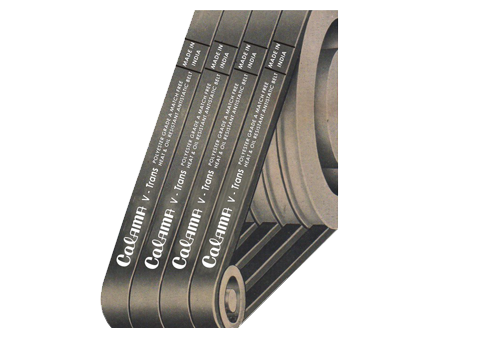The Calama V Belt is a precision-engineered component widely used for efficient power transmission in mechanical systems. Recognized for its versatility and reliability, it plays a critical role in driving and synchronizing components in machinery across various industries.
Product Specification of V Belt
- Brand: Calama
- Material:
- Product Dimensions:
- Centimeters:
- Item Weight:
- Color:
Key Features and Benefits of V Belt
- Unique V-Shaped Profile
- The V-shaped cross-section allows the belt to wedge firmly into pulley grooves, increasing friction and reducing slippage.
- This design ensures a tight grip even under high torque loads, making it ideal for heavy-duty applications.
- High-Quality Construction
- Material: Made from premium-grade rubber compounds, often reinforced with synthetic materials like polyester or Kevlar cords.
- Durability: The reinforced cords enhance tensile strength, reducing stretch and maintaining consistent performance over time.
- Flexibility: Designed to bend around small pulley diameters without cracking or compromising structural integrity.
- Optimized Performance
- Power Transmission Efficiency: Delivers smooth, vibration-free operation with minimal energy loss.
- Heat & Oil Resistance: Special rubber compounds resist degradation from high temperatures and exposure to oils or chemicals.
- Abrasion Resistance: Withstands wear caused by friction and continuous operation.
- Versatile Applications
- Used in a broad range of sectors, including:
- Automotive: Driving alternators, water pumps, and air conditioning systems.
- Industrial: Transmitting power in conveyor systems, pumps, compressors, and more.
- Agricultural Equipment: Powering combine harvesters, tractors, and other machinery.
- HVAC Systems: Essential for fans and blowers in heating and cooling systems.
- Wide Range of Options
- Available in multiple sizes, including standard profiles (e.g., A, B, C, D, E) and custom lengths to suit specific needs.
- Can support various load capacities, speeds, and pulley arrangements, from single to multi-belt configurations.
Technical Specifications
- Cross-Section: Standard and custom V-belt profiles (A, B, C, etc.)
- Lengths: Available in fractional inches or metric measurements.
- Tensile Strength: Ranges from medium to high strength, based on application requirements.
- Operating Temperature Range: Typically -30°C to +80°C (-22°F to 176°F), depending on the material.
Advantages Over Other Belts
- Compact Design: Requires less space than flat belts while transmitting higher power.
- Self-Centering Capability: The wedging action helps maintain alignment within pulleys, reducing maintenance needs.
- Long Service Life: Resistant to environmental factors like moisture, heat, and contaminants, ensuring longevity.
Usage and Maintenance Tips
- Ensure the belt is matched to the correct pulley size and profile for maximum efficiency.
- Regularly inspect for signs of wear, such as cracks, fraying, or excessive stretching.
- Maintain proper tension during installation to avoid slippage or premature wear.
- Use compatible lubricants and cleaners to extend belt and pulley life.
FAQs for Calama V Belt
1. How does a V Belt work?
The V-shaped design allows the belt to wedge into the grooves of a pulley, creating friction. This friction increases as the load grows, ensuring the belt stays in place and transmits power effectively without slipping.
2. What materials are V Belts made of?
V Belts are typically made from durable rubber compounds reinforced with synthetic fibers, such as polyester, Kevlar, or aramid cords. These materials provide strength, flexibility, and resistance to wear, heat, and chemicals.
3. What are the types of V Belts?
Common types of V Belts include:
- Classical V Belts: Standard sizes (A, B, C, D, etc.) used for general applications.
- Narrow V Belts: Higher power capacity in a smaller profile (3V, 5V, 8V).
- Cogged V Belts: Have notches for better flexibility and heat dissipation.
- Bandless/Joined V Belts: Multiple belts joined together for heavy-duty applications.
4. How do I choose the right V Belt?
To select the right V Belt, consider the following:
- Belt Profile: Match the cross-section (A, B, C, etc.) to your pulley grooves.
- Length: Measure the belt’s required length based on your pulley configuration.
- Load Capacity: Ensure the belt can handle the torque and speed of your application.
- Environmental Factors: Choose materials resistant to heat, oil, or chemicals if needed.
5. How do I measure a V Belt?
To measure a V Belt:
- Identify the top width and thickness of the belt.
- Measure the belt's outer circumference (or use a flexible tape measure to measure the existing belt’s length).
- Consult the manufacturer's sizing chart to match these measurements.
6. What causes V Belts to wear out?
Common causes of wear include:
- Improper tension (too tight or too loose).
- Misaligned pulleys.
- Excessive heat or exposure to oil/chemicals.
- Overloading or exceeding the belt’s capacity.
- Lack of regular maintenance.
7. How do I maintain a V Belt?
To ensure longevity:
- Regularly inspect for cracks, fraying, or excessive wear.
- Adjust the tension to the manufacturer’s specifications.
- Align pulleys to prevent uneven wear.
- Replace worn-out belts promptly to avoid system failure.
8. Can a V Belt be repaired?
No, V Belts are not typically repairable. If a belt is damaged or worn out, it should be replaced with a new one to maintain system reliability and safety.
9. How often should I replace a V Belt?
The replacement frequency depends on usage, operating conditions, and quality. On average, V Belts last 3-5 years under normal conditions. Regular inspections help identify when replacement is needed.
10. Are V Belts interchangeable?
Not always. While some belts may have similar dimensions, material differences, and design specifications (e.g., cogged vs. non-cogged) can affect performance. Always consult the manufacturer’s guide for compatibility.
